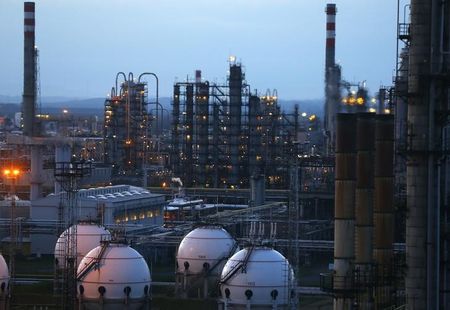Commodities
Oil prices rise continue to climb on heightened Middle East tensions

Investing.com– Oil prices climbed strongly Monday, extending recent gains on fears on a wider Middle East war.
At 08:20 ET (12:20 GMT), rose 1.7% to $79.39 a barrel and climbed 1.9% to $75.78 a barrel.
Both contracts rallied between 8% and 10% last week, as the raised Middle East tensions were boosted by the positive U.S. payrolls data, which lifted hopes that the US economy was more resilient than initially feared.
Still, trading volumes were somewhat limited on account of golden week holidays in China. Chinese markets are set to reopen on Tuesday.
Supply disruptions in focus on 1-year anniversary of Israel-Hamas war
Oil bulls built on bets of Middle East supply disruptions as the Israel-Hamas war showed few signs of cooling. Monday marked a year since the Hamas attack on Israel triggered renewed hostilities between the two.
Reports on Monday said Hezbollah rockets had hit Israel’s third-largest city of Haifa.
Israel struck Hezbollah targets in Lebanon and the Gaza Strip on Sunday, days after Iran launched a large-scale missile strike against Israel over its activities against Hezbollah and Hamas.
Reports said Israel was considering attacking Iran’s oil production facilities – a move that could disrupt oil supplies and mark a drastic escalation in the conflict.
Demand cues, interest rates remain in focus
Oil markets remained focused on more cues on demand, especially after top importer China announced a slew of stimulus measures over the past few weeks.
Positive U.S. labor market data also helped spur some optimism over demand in the world’s biggest fuel consumer. But the reading sparked sharp gains in the dollar, which in turn weighed on crude prices.
spike possible – BCA
The risks of a spike in crude oil prices have increased, according to analysts at BCA Research.
While BCA maintains a cyclical outlook that crude prices are likely to weaken over the next six to nine months, the immediate market environment is fraught with uncertainties that could support higher prices in the near term.
Geopolitical tensions, particularly the escalating conflict in the Middle East, are creating supply-side risks that have jolted market participants awake to the possibility of a supply shock.
This potential disruption comes at a time when the region accounts for a substantial portion of global crude output, raising alarms over the possibility of infrastructure being targeted in future retaliatory attacks.
Despite these concerns, BCA Research notes that there is still ample spare capacity within the OPEC+ bloc to offset any temporary supply shocks.
Key OPEC+ producers have been withholding significant production, and they might be willing to step in and increase output to stabilize the market.
The group kept production unchanged during a meeting last week, but also reiterated plans to begin increasing production from December.
(Ambar Warrick contributed to this article.)
Commodities
Oil prices rise; U.S. crude inventories plunge, Russia-Ukraine truce eyed
Commodities
India’s Reliance to stop buying Venezuelan oil over US tariffs, sources say
Commodities
Oil prices climb on Venezuela supply worries

 Forex3 years ago
Forex3 years agoForex Today: the dollar is gaining strength amid gloomy sentiment at the start of the Fed’s week

 Forex3 years ago
Forex3 years agoUnbiased review of Pocket Option broker

 Forex3 years ago
Forex3 years agoDollar to pound sterling exchange rate today: Pound plummeted to its lowest since 1985

 Forex3 years ago
Forex3 years agoHow is the Australian dollar doing today?

 Cryptocurrency3 years ago
Cryptocurrency3 years agoWhat happened in the crypto market – current events today

 World3 years ago
World3 years agoWhy are modern video games an art form?

 Commodities3 years ago
Commodities3 years agoCopper continues to fall in price on expectations of lower demand in China

 Economy3 years ago
Economy3 years agoCrude oil tankers double in price due to EU anti-Russian sanctions



























